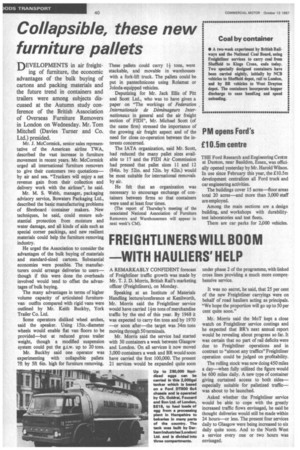Collapsible, these new furniture pallets
Page 42

If you've noticed an error in this article please click here to report it so we can fix it.
DEVELOPMENTS in air freight ing of furniture, the economic advantages of the bulk buying of cartons and packing materials and the future trend in containers and trailers were among subjects discussed at the Autumn study conference of the British Association of Overseas Furniture Removers in London on Wednesday. Mr. Tom Mitchell (Davies Turner and Co. Ltd.) presided.
Mr. J. McCormick, senior sales representative of the American airline TWA, described the vast increase in furniture movement in recent years. Mr. McCormick urged all international furniture removers to give their customers two quotations— by air and sea. "Truckers will enjoy a net revenue gain from their collection and delivery work with the airlines", he said.
Mr. M. S. Webb, manager, packaging advisory service, Bowaters Packaging Ltd., described the basic manufacturing problems of fibreboard container makers. New techniques, he said, could ensure substantial protection from moisture and water damage, and all kinds of aids such as special corner packings, and new resilient materials could help the furniture removing industry.
He urged the Association to consider the advantages of the bulk buying of materials and standard-sized cartons. Substantial economies were possible. The manufacturers could arrange deliveries to users— though if this were done the overheads involved would tend to offset the advantages of bulk buying.
The many advantages in terms of higher volume capacity of articulated furniturevan outfits compared with rigid vans were outlined by Mr. Keith Buckby, York Trailer Co. Ltd.
Some operators disliked wheel arches, said the speaker. Using 15in.-diameter wheels would enable flat van floors to be provided—but at reduced gross trailer weight, though a modified suspension system could put the g.t.w. up to 20 tons.
Mr. Buckby said one operator was experimenting with collapsible pallets 7ft by 5ft 6in. high for furniture removing. These pallets could carry 11 tons, were stackable, and movable in warehouses with a fork-lift truck. The pallets could be put in pantechnicons using Rolamat or Joloda-equipped vehicles.
Deputizing for Mr. Jack Ellis of Pitt and Scott Ltd., who was to have given a paper on "The workings of Federation Internationale de Detnenageurs Internationaux in general and the air freight section of FIDI", Mr. Michael Scott (of the same firm) stressed the importance of the growing air freight aspect and of the need for close co-operation between the interests concerned.
The IATA organization, said Mr. Scott, had reduced the many pallet sizes available to 1.7 and the FIDI Air Commission had pressed that pallet sizes 11 and 12 (84in. by 52in. and 52in. by 42in.) would be most suitable for international removals by air.
He felt that an organization was necessary to encourage exchange of containers between firms so that containers were used at least four times.
(The report of Thursday's meeting of the associated National Association of Furniture Removers and Warehousemen will appear in next week's CM).
PM opens Ford's £10.5m centre
THE Ford Research and Engineering Centre at Dunton, near Basildon, Essex, was officially opened yesterday by Mr. Harold Wilson. In use since February this year, the L10.5m development centralizes all Ford truck and car engineering activities.
The buildings cover 15 acres—floor areas total 20 acres—and more than 3,000 staff are employed.
Among the main sections are a design building, and workshops with durabilitytest laboratories and test fleets.
There are car parks for 2,000 vehicles.


































































































































